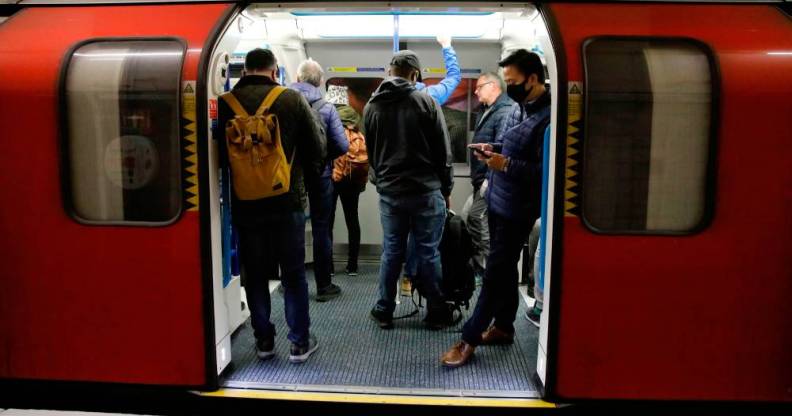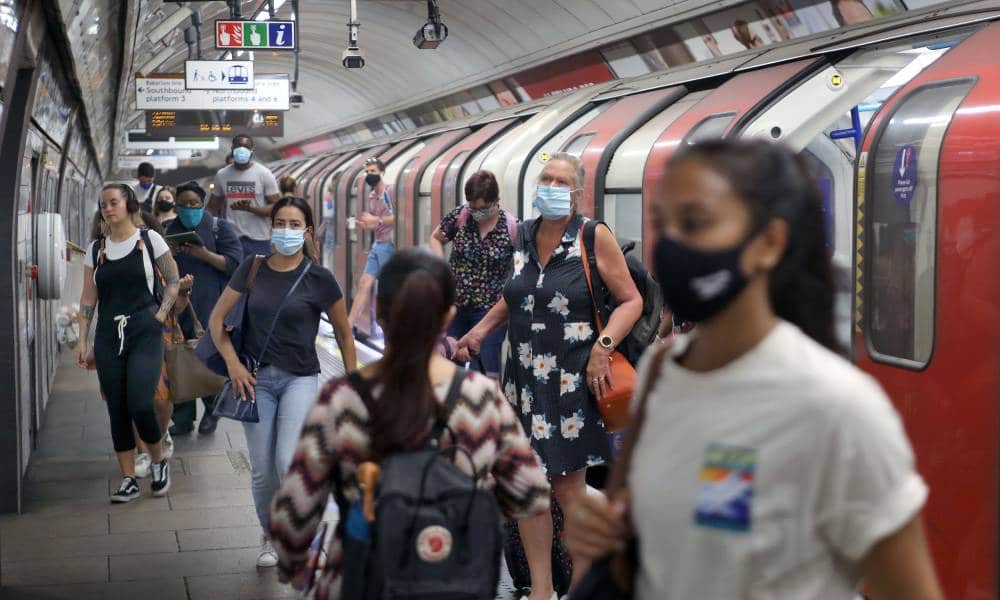Sexual harassment isn’t always obvious – but it’s vital we all recognise it

Passengers on the Tube. (Tolga Akmen/AFP via Getty)
Sexual harassment has been allowed to exist as a “hidden problem” for far too long.
Unwanted, and often criminal, sexual behaviour is pervasive in public spaces – on the streets, in bars, and often, on public transport. In the capital, over half (55 per cent) of female Londoners have experienced sexual harassment on public transport, according to a YouGov poll, as well as 21 per cent of men (the research and its outcomes did not consider people outside the gender binary).
Ninety-four per cent of perpetrators are men, according to National Rail research.
It’s a situation described as “endemic” by Women’s Equality Party leader Mandu Reid – however, in the vast majority of cases, it’s going unreported.
A culture of victim-blaming and distrust of police means that those who are victims often don’t seek justice – just two per cent report to staff, and another two per cent report to police, YouGov found. In almost half (49 per cent) of cases, the victim kept it to themselves. And despite its prevalence, many people don’t recognise sexual harassment when they see it – National Rail research found that just 10 per cent of women and 12 per cent of men report witnessing it.
This can have a massive effect, as Ella recently discovered on a four-stop journey during a commute on a London Tube. About a perpetrator sitting next to her in the carriage, she told PinkNews: “He said some awful words and stroked my arm. I knew that CCTV would not catch what he said to me because he was wearing a mask. I was so frightened.” Bystanders on the carriage, she said, were silent. The impact, she said, regardless of how small an incident may appear, “is massive”.
Although TfL and National Rail do not tolerate such behaviours on the public transport network, they remain prevalent due, in part, to the anonymity the environment provides along with the crowded spaces into which perpetrators can easily disappear into. Perpetrators have been known to ‘accidentally’ rub up against unsuspecting passengers, purposefully standing next to them when they know the space is crowded.
Other forms of sexual harassment include publicly viewing pornography, flashing, up-skirting, stalking, sexual jokes, leering, taking photos of a sexual nature without consent and making sexual comments. Other related issues include intensive staring of a sexual nature, which can lead to harassment, and cat-calling, or making unsolicited remarks of a sexual nature.
Society often considers some of these to be more serious than others, but so-called “minor” offences should not be ignored at all, said Women’s Aid chief executive, Farah Nazeer.
She told PinkNews that perpetrators of sexual harassment, “regardless of how ‘minor’ these offences may seem, should be closely monitored by the police. Women should not have to take all the burden of responsibility for their own safety.”
The overwhelming majority of perpetrators are men targeting women. Queer and trans people are at significant risk of sexual harassment, with homophobia and transphobia often leading into sexual behaviours.

Most passengers on the London Underground wear face coverings. (Martin Pope/SOPA Images/LightRocket via Getty)
Psychologist and author Dr Jessica Taylor has spent a decade working in violent crime against women and girls. Taylor explained: “When you’re a lesbian, you’re the ultimate insult to those men who feel entitled to women’s bodies. So you’re almost affronting them by being with a woman, but all they can do is sexualise you. That entitlement has to be dealt with but it’s also much broader than towards lesbians; it’s towards all women and girls.”
Queer intersectional feminist Gemma Tutton, 15, is fighting to incriminate all forms of public sexual harassment with the Our Streets Now campaign, which she was propelled to launch with her sister Maya after being “sexually harassed” by three men on her way home from school at the age of 13.
She told PinkNews: “Queer people experience heightened rates of unwanted sexual attention, our experiences often being more intrusive, sexual and aggressive. For women and femmes, this is because of the intersection of misogyny and of homophobia/transphobia, intensifying the disrespect and fetishisation of both of our oppressed identities.
“This is only worsened for queer people of colour and queer disabled people. Our identities are not separate; misogyny on its own can be fatal, however transmisogyny and misogynoir, the product of two types of oppression, are even more hateful and dangerous.”
What can you do as a bystander?
The onus to deter unwanted sexual behaviour is not on the public and intervening in certain situations can be dangerous. But TfL advises that there are steps witnesses can take if it is safe to do so.
Always be vigilant by looking out for each other if something does not feel right. If you are a bystander witnessing someone at the receiving end of public sexual harassment, it is advised to immediately call or text police, or speak with a member of staff via the help point or passenger alarm on platforms.
If you can, lock eyes with the person being harassed and, if it is safe to do so, engage them in a conversation about anything but the situation, ignoring the offender and their behaviour. Check the person being harassed is OK and ask a fellow passenger to help by also engaging to demonstrate the power and solidarity shown by numbers.
Directly challenging the offender about their behaviour is risky and you should assess any situation very carefully before speaking up. Avoid putting yourself in harm’s way. The interventions above can be a more effective and safer way to help.
Evidence can massively help the situation, so once you have assessed the situation, and if doing so will not put you at risk of harm, record the incident on your phone and give the footage to police.
See it or experience it on public transport? Report an incident on the bus network at met.police.uk For all other TfL services, text British Transport Police on 61016. In an emergency, always dial 999.

